9/25 - Tuesday – Antigonish (Chateau Motel) to Darmouth/Halifax
We happily packed up and left our little shabby, hole-in-the-little motel (Chateau Motel) and went back to “Sunshine on Main Street” for breakfast. We had the best oatmeal and berries. We were right in the middle of student land – seeing all the students scurrying about made me miss my ole college days.
It was a beautiful drive south from Antigonish to Sherbrooke Village perfectly situated on St. Mary’s River. We arrived at 9:30a.m., opening time. However, we spent oven an hour with sweet Nora Fraser at the Visitor’s Center trying to find a room for two nights in the Halifax area. Halifax was booked solid so we decided to stay in Darmouth (at a private residence B&B called The Elm Tree) and take the ferry into Halifax. Having booked a place to rest our bodies for tonight, we were finally free to explore Sherbrooke Village. We paid $7.50 each for admission to the village, but it was well worth it.
Sherbrooke Village is a restored 19th Century village in Nova Scotia. St. Mary’s is a peaceful river that runs right by the village giving the place such a special feeling. Some of the homes are still privately owned. I adored the houses and buildings in the town, each had its own personality – hard to describe. The town is populated with lots of folks in costumes going about life in the 1860’s. It was a chilly, windy day. We’d enter a house and there would be a fire blazing and maybe cookies baking – gave you a real feeling for what it must have been like.
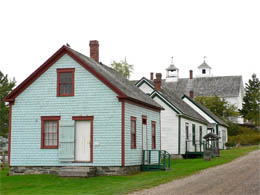
Sherbrooke Village |

Main Street |
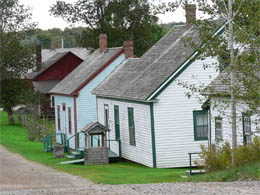
Sherbrooke Village Residential Area |
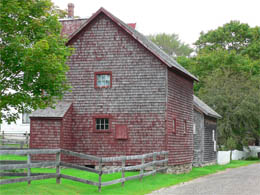
Farmhouse |
| Sherbrooke Village – A little background . . . In 1655, the French were the first Europeans to settle in the area. They built the town near the banks of the St. Mary River and called the place Fort Sainte Marie.
In 1815, the town developed as a center for navigation and was renamed Sherbrooke after John Sherbrooke, Lt. Governor of Nova Scotia.
Sherbrooke was a very prosperous community with a diversity of successful businesses – farming, fishing, timber (and lumber mills), ship building (and shingles for homes), and so on. Trade between the British and the West Indies added to the wealth.
In 1861, gold was discovered. By 1869, there were 19 companies that came to Sherbrooke in search of gold. That lasted about 20 years, but lumbering remained the major industry.
In 1969, the Sherbrooke Village Restoration project began and created this wonderful little town for us to get a peek into the past. |
We went door to door visiting all the buildings in town that were not privately owned. We talked to the merchants and towns folk and just had a great day. (One tour bus unloaded 40 passengers, but they stayed only about an hour and then the town was ours again.)
Following are some of the places we visited and some of the things we learned.
Sherbrooke Hotel and What Cheer Tearoom – proper and classy, but too pricey for us poor Americans.
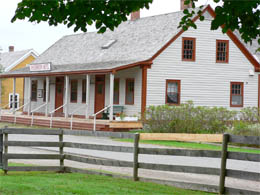
Sherbrooke Hotel |
Blacksmith’s (established in the 1870’s by Joe McLane) – The resident blacksmith made a hook for one of the school kids. As he created the hook, he explained the process – bellows, burning embers, melting iron, forming the iron (by twisting and pounding), cooling in water, then twisting and pounding again. I learned so much from that demonstration. My great-grandfather was a blacksmith and now I understand what an art it is.
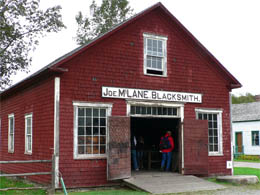
Joe McLane’s Blacksmith Shop |
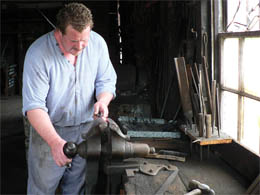
Blacksmith doing his work |
Post Office (from 1850’s) – Mail came in by ship once a week and loaded in leather bags for delivery. The Post Mistress showed us how they made copies then with onionskin paper, water and a press. While I was visiting the post office, I got a call from Maxine on the switchboard down at the Telephone Exchange. She invited us down to visit her later.
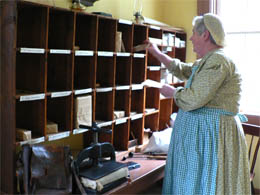
The Post Mistress |
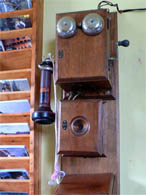
Telephone at the Post Office |
The following notice was posted on the wall at the Post Office:
No horse shall be allowed to run at large in the Village of Sherbrooke.
No sheep, swine or geese shall be allowed to run at large on the streets of said village.
No cattle shall be allowed to run at large on the streets at night.
Penalties for the foregoing Regulations, viz: in the case of horses – One Dollar for the first offence, and two dollars for every additional offence.
For sheep, swine, geese and cattle, fifty cents for the first offence, and one dollar for every additional offence.
The Court of General Session, 1867
|
St. Mary’s Printing – was stacked with moveable letters and paper. The proprietor printed out a recipe for me using a foot driven press – very interesting. (I would have been a printer – I liked all that ink and layout and paper.)
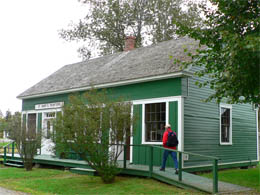
St. Mary’s Printing |
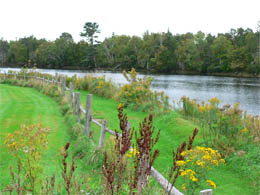
St. Mary River runs by the town |
Drug Store (1890’s) – displayed items for sale (eye wash, brushes, medicine, etc.) In the back of the store (where the doctor lived), a jolly little woman was making hand cream with bee’s wax, borax, and rose water. She was carefully weighing each item on an old fashion scale. I tried the cream and really liked it, but it was $15 for just a small jar, so we passed.
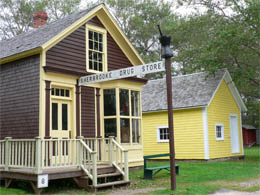
Sherbrooke Drug Store |

Goods for sale |
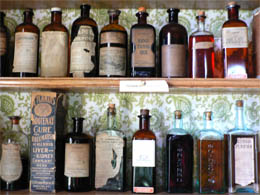
Snake oil |
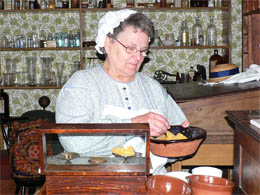
Making hand cream |
Jail (1862) – used for 100 years as a house for both the jailer’s family and the prisoners. When we arrived, kids, dressed in period clothes, were baking cookies. The cookies were yummy – hope the kids washed their hands!
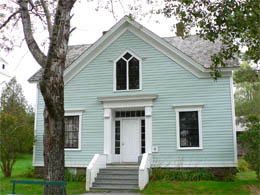
Jailhouse and home for the Jailor and his family |
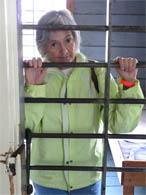
Nancy, after being booked and fingerprinted |
Tailor Shop – started by Donald MacDonald when he was only 18. His main business was suits for men and boys -- took him 3 days to make one. He also sold hats, buttons, fabric and other sewing items. His son took over the business.
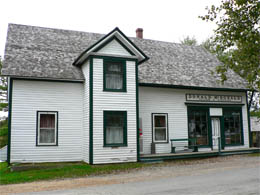
Tailor’s Shop |
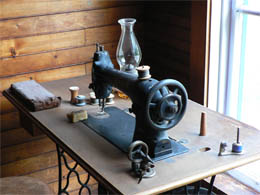
Tailor’s equipment |
Pottery – The potter was making earthenware pottery. He was talking to another couple, ignoring us, so we left.
Boat Building Shop – loved the beautiful wooden, crafted boats. The builder must have been on a coffee break because no one was there.
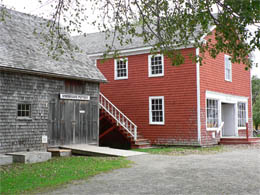
Pottery Shop |
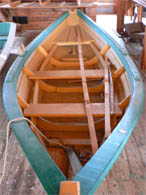
Boat Building Shop |
Masonic Hall – Tuesday night meetings are held in the hall upstairs and have been for decades. It was creepy looking – it had bad vibes. Downstairs was a fascinating tool exhibits – Never stopped before to realize the importance of tools in building a town.
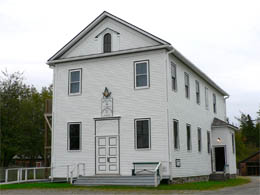
Masonic Hall |
Cumminger Brothers General Store (1870’s) – operated by John and Samuel Cumminger. They were also in the lumber / shipbuilding business. Brother John was a shipmaster and captain. He sailed all over the world to bring goods to this store.
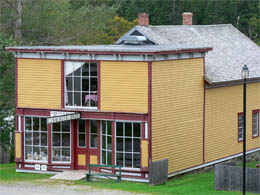
Cumminger Brothers General Store |
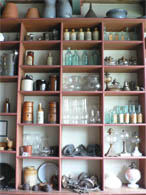
Goods for sale |
NOTE: The woman at the counter asked where we were from. We told her California. Her quiet reply was: “Hope we can still be friends.” Apparently Bush (and Cheney) are doing some more saber rattling. Wish I could say to him, “Get over it, Cowboy. The world hates you . . . and now us.”
Greenwood Cottage – was built in 1871 by John and Sarah Cumminger and is a real showplace Victorian style house.
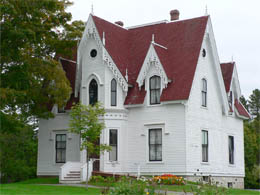
Greenwood Cottage |
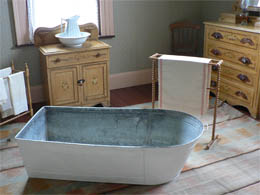
Bathroom |
Telephone Exchange – nobody was there -- Maxine on the switchboard must be with the boat guy on their coffee break. (Sorry I didn’t meet her – sounded like a very friendly gal.)
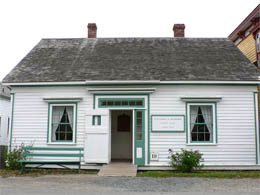
Telephone Company (Central Office) |
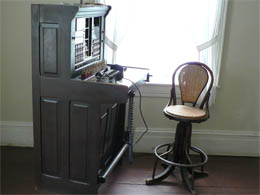
Switchboard – Where’s Maxine? |
Courthouse (1858) – Great old place -- You could hear the judge’s gavel and feel the excitement of years of courtroom drama.
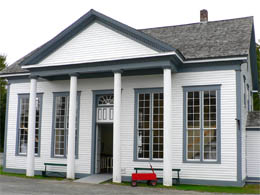
Courthouse |
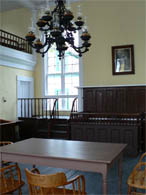
Courthouse chambers |
Temperance Hall (1892) – The hall was also a Legion Hall – There were a few dry Legionnaires in Canada. It was an odd place. A blind woman was hooking a rug and doing quit well.
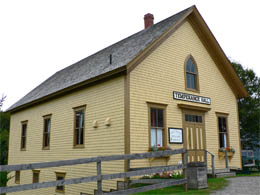
Temperance Hall |
Schoolhouse (1876) – as an old school teacher, schoolrooms are always fun to visit.
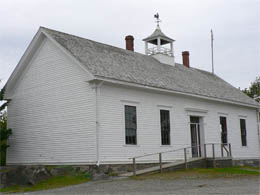
Schoolhouse |
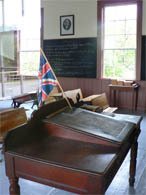
Schoolhouse interior |
McMillian House (1870) – cozy home with a weaver working on a loom. (The loom looked the one I had and let somebody borrow – never to see again!)
St. James Presbyterian Church – Lovely on the outside, but had an ugly yellow paint on the inside.
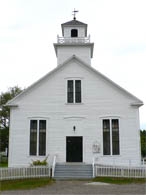
St. James Presbyterian Church
|
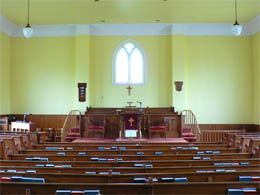
Church
interior |
After we did the town we went down the road to see the sawmill, lumber camp and stamp mill (for mining gold). A friendly guy, running the place by himself, told us where to find the lumber camp and stamp mill and best yet, where the locals go for a burger.
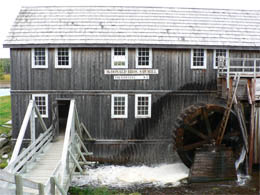
McDonald Brothers Sawmill |
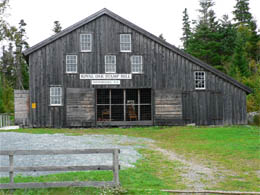
Royal Oak Stamp Mill |
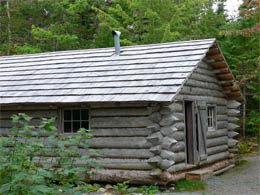
Lumberjacks’ cabin |
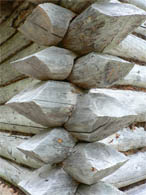
Fits together just like Lincoln Logs |
After exploring the milling operation and the lumber camp, we headed to Main Street in the new Sherbrooke (not part of the re-created village) and found the spot for lunch that the lumber mill guy recommended. We ordered a $2.95 burger at the Main Street Café along with a couple of chocolate chip cookies for dessert. The cookies were 5 star yummy (and I’m very picky about my c-c cookies)!
After lunch (around 2 pm), we walked to the little library to check emails – not much news from home, which means “good news,” I suppose.
We had a 2-½ hour drive ahead of us. We went west on Highway 7 along the southern coast to Darmouth / Halifax. The drive was breathtaking – lakes, green-green pastures, farms – beauty galore.
However, “The Bitch” was mixed up a lot and wanted us to take down a couple of dirt roads. Bill defended her, which didn’t please me. I’ll have to say that she did get us to The Elm Street B&B in a hilly quiet Darmouth neighborhood loaded with winding, twisting streets. We had only an address and would have been sunk without her. We met Marg and Ron (her hubby). We really liked them and their cozy little home. (Can’t believe it’s only $80 a night!)
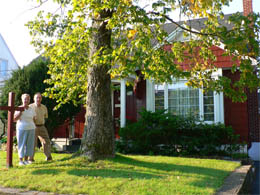
The Elm Street B&B |
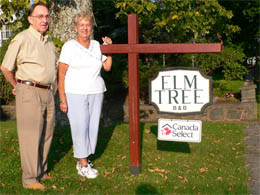
Ron and Marg, great people, great place! |
After we unpacked, we drove a couple of miles down to the Darmouth Wharf (Alderney Gate Complex) for dinner at MacAskill’s (88 Alderney Drive). We had a lovely dinner – salmon fettuccini and Moosehead beer (of course) – with wonderful views of the Halifax Harbor across the bay.
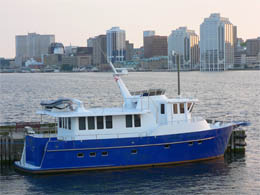
View of Halifax from the Darmouth Wharf |
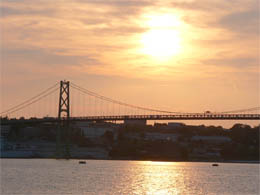
Beautiful sunset! |
On the way home we stopped at a bank to get more loonies – really go through money fast. We got home at about 8 and chatted with Ron and Marg. (Wanted to call Amy to find out her interview went, but misplaced the phone card.) Nice weather predicted for tomorrow.
9/26 - Wednesday – Dartmouth/Halifax
Hot summer day – Marg served us a huge gourmet breakfast on her lovely china in her beautiful dining room. I didn’t want to stop eating the blueberry pancakes. Man, did we score when we found this place!
We were stuffed when we headed to the Dartmouth wharf. We stopped by the Visitor’s Center where Beverly booked a B&B in Lunenburg for tomorrow. We caught the 9:30 ferry to Halifax. Gorgeous summer-like day – The views of Halifax from the ferry were grand. After only 15 minutes, we arrived in Halifax, de-ferried and started on our long “must see” list.
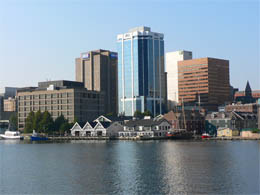
Halifax viewed from the Ferry |
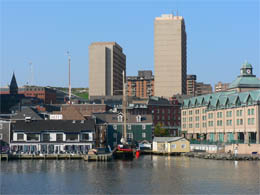
Halifax wharf |
The Maritime Museum of the Atlantic was first on our “must see” list. We were greeted by a loud parrot and a hanging pirate. The parrot was making a lot of racket – but the pirate was just swinging quietly. Several pirates did, in fact, have parrots, but it was Robert Louis Stevenson who really set that association.
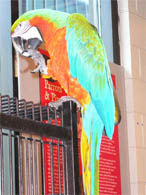
What a noisy critter! |
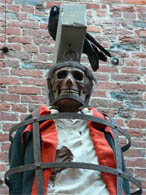
Pirate hung in a cage |
We learned that Halifax is rich in maritime treasures. For one thing, it was the perfect place to transport soldiers and war goods. Because of its harbor and location, Halifax played a key role in several wars – the war between the French and English (at Ft. Louisburg – 1750’s), the American Revolution, WWI, and WWII. Huge convoys were dispatched from these waters. In fact, in WWII, huge nets were placed in the harbor at night to block German submarines. The Germans were definitely here. In fact, one German soldier escaped from his submarine and made his way to a farmhouse. The woman at the farmhouse greeted him, then called the authorities and turned him in. He spent the rest of the war in a POW camp.
Halifax (and Nova Scotia) was also heavily involved in shipwrecks. Because of this, the museum had several amazing eye-grabbing exhibits.
Titanic display
April 14, 1912 at 11:50 pm, the Titanic struck an iceberg and sank 700 nautical miles east of Halifax, the closet major seaport. Over 2200 people were aboard the Titanic and only 705 survived. Halifax was the headquarters for rescue and recovery operations. That’s why the Maritime Museum in Halifax has the world’s largest collection of Titanic items -- deck chair, cribbage board, little pair of shoes, and lots of other items. (The shoes are believed to be from Body No. 4, the “Unknown Child”. The boy’s body, approximately 2 years old, was buried at the Fairview Lawn Cemetery in Halifax, which we visited later in the day.)
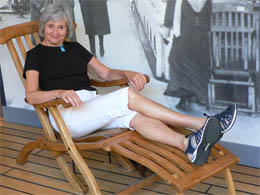
Nancy resting on a replica of a deck chair from the Titanic |
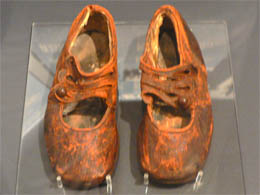
Shoes of the unknown children who died during the Titanic tragedy |
The displays were like looking through a scrapbook where we got to know several souls who perished – a young doctor, a woman traveling with her four children, members of the crew and so on. (Later in the day, we visited some of the graves at Fairview Cemetery on the outskirts of Halifax. 150 victims of the Titanic are buried in Halifax; many of the graves only listed a number, no name.)
We read in horror some of the details. The first class passengers were given lifeboats while gates were locked, blocking the other passengers’ access to a lifeboat. Just as in life, the same caste system governed how the bodies were handled. The first class bodies got coffins; the others got canvas bags and the crew got stretchers.
An intricate system was developed for identifying the bodies. The clothes and items of the victims were burned to stop the onslaught of souvenir seekers. We had barely recovered from the Titanic horror stories when the loud speaker announced a presentation on another Halifax tragedy – the explosion of 1917.
Halifax Explosion, December 6, 1917 In 1917, Halifax was the hub of Canada – the harbor was jammed with wartime shipping vessels. The town was a staging area for sending troops, munitions, and equipment to Europe.
At 7.30 a.m. on December 6, the French ship Mont-Blanc (loaded with tons of explosives -- TNT) was navigating through Halifax’s narrow bay while the Belgium Relief ship Imo was setting off for New York to pick up relief supplies. At the entrance to the Narrows, the Imo’s nose scrapped the Mont-Blanc on the bow. Although there wasn’t much damage, fire broke out on board the Mont-Blanc.
The French captain, pilot and crew were about the only ones who knew that their boat was loaded with explosives and would blow up at any minute. They jumped into the lifeboats and rowed like crazy to the Dartmouth shore. On their way, they yelled and tried to warn the locals of the impending disaster, but could only speak French, so no one understood them. When they reached the shore, they dashed up the hill to run for cover behind some trees. One French sailor grabbed a woman’s baby as he ran. The mother chased after him and ultimately both the mother and baby were saved from the blast.
Before it blew up, the Mont-Blanc burned for twenty minutes, drifting to the busy, industrial north end of Halifax. Crowds gathered down by the dock to watch the burning ship, unaware of the danger.
For some reason, a man at the telegraph office knew the boat was packed with explosives and sent a message to the railroad company to stop the incoming train. The train was diverted and many lives were saved – however, the telegraph operator lost his life.
About 9.05 a.m., the Mont-Blanc blew up causing the biggest explosion in pre-Hiroshima times. A 60 feet tidal wave hit because so much water had been displaced by the explosion in the bay. The Mont-Blanc was demolished and sent hunks of shrapnel flying into the city. (One example is a hunk of metal embedded in St. Paul’s Church entryway.)
Churches, houses, schools, factories, docks and ships were flattened in the blast. Children on their way to school, workmen lining the docks, families in their homes, sailors in their ships, died instantly or suffered frightful injuries. Hardly a pane of glass in Halifax and Dartmouth was left intact. The flying glass blinded many (and later a School for the Blind was established in the city.)
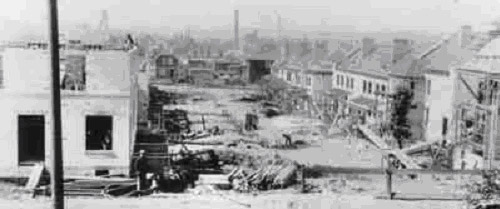
After the Explosion |
1,630 homes were completely destroyed, many by fires that spread following the explosion; 12,000 houses were damaged; 6,000 people were left homeless. The death toll was at least 2,000. About 250 bodies were never identified. Many victims were never found. Twenty-five limbs had to be amputated; more than 250 eyes had to be removed; 37 people were left completely blind. Hospitals were packed.
NOTE: After a series of court battles, blame for the accident was never determined in the largest man-made explosion until the atomic age.
As if the city hadn’t suffered enough, the next day (December 7, 1917), a terrible blizzard hit the city. News of the disasters spread quickly and the help from Canada, U.S. and other parts of the world poured in. Boston sent a night train loaded with supplies and volunteers. Because of Boston’s support, each year the people of Nova Scotia send a huge Christmas tree to Boston to stand in Prudential Plaza as a thank-you gift.
The museum displayed many personal items and stories – blood stained baby dress, school backpacks (that save 2 of 3 brothers on their way to school), three stubby little pencils from a school child who was killed, photos of a minister and his children whose wife was killed, and the images go on. We watched a poignant video of the survivors telling their stories. One girl was 17 at the time whose face was scarred in the explosion. She said that her scarred face left scares inside for the rest of her life.
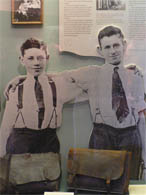
The two brothers saved by their school backpacks |
NOTE: Robert Oppenheimer later studied the effects of the explosion in calculating the strength of the bombs for Hiroshima and Nagasaki.
Shipwreck Display We were on disaster overload when we came to the shipwreck exhibit. Because many ships went down in the waters near Halifax (and around Nova Scotia) the museum contains the dramatic history (in photographs, paintings and articles from the ships) of historic shipwrecks starting with the sinking of the of the Prudent in Louisburg in 1758 and ending with the sinking of the Kurdistan in the Cabot Strait in 1979.
I went from display case to display case with eyes glazed over, focusing on treasure chests, silver and gold coins, cabinets and other rare archaeological finds. There were so many fascinating stories of battles, stow-aways, pirates, mutinies and other adventures of these sea-going people.
Sailors’ Superstitions
A docent gave a cute presentation of some of the superstitions from the shipping culture. She was dressed as a sailor and acted out some of the crazy beliefs –
- No whistling
- Don’t carry a black bag
- Don’t leave on a sailing journey on a Thursday or Friday
- If you hear church bells ringing, some one will die.
Sailing Vessels
We ventured into a huge room filled with small sailing boats – of which I know very little, but the displays were very impressive.
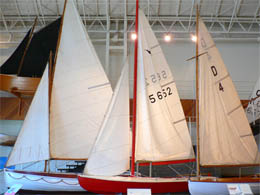
Gallery of Small Craft |
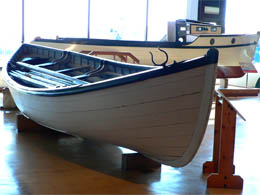
A Dory |
In another room we learned about the Bluenose, the famous schooner, launched in 1921, and source of great pride in Canada. In a dramatic series of races, the Bluenose raced the American vessel and won. Canada’s 50-cent stamps carry the image of the Bluenose.
The original Bluenose was destroyed, but the replica, Bluenose II, still hangs out in Canada's waters. (A few days later, we saw Bluenose II docked at Lunenburg and learned more about her . . . more info to come.)
Angus Walters was the captain and owner of the ship and the young Halifax designer, William J. Roue (1880-1970) was the ship’s architect. Roue was a self-taught naval architect who designed over 100 ships in his lifetime, and became the greatest designer of wooden vessels in Canadian history.
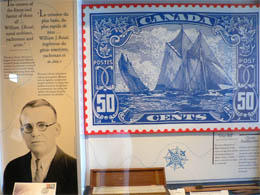
W. J. Roue (designed the Bluenose) – Image on stamps |
Restored mariners’ store
Stacks of things shipping people would need were displayed in the restored store, William Robertson & Son Ship Chandlery. It was just like a “Home Depot” with things to satisfy every ship-related need in the 1800’s to early 1900’s. Apparently, the huge area set aside in the museum were the actual rooms of the original store.
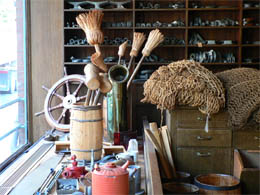
Merchandize from William Robertson & Son Ship Chandlery |
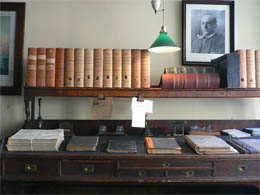
The business office |
A Pirate’s Myth & Reality We browsed through the Pirate’s room with the stories of real pirates connected to Nova Scotia's history. We saw an actual skull of a pirate executed in Halifax in 1809, a replica of a skeleton on a gallows, Oak Island pirate artifacts, weapons from the Golden Age of Piracy (1680-1730), and other pirate
paraphernalia.
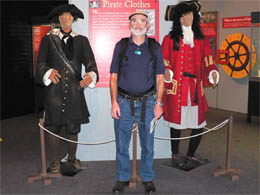
Bill and his pirate buddies |
The
penalties
were stiff for
pirates who were
captured. The law required that the pirates be executed with their bodies displayed in public as a warning to other sailors. Their bodies were covered in tar and hung from chains in an iron cage called a gibbet. The Royal Navy used the same treatment on mutineers. In 1809, six mutineers were hung just across the Halifax Harbor. Any ship entering Halifax had to pass between hanging and rotting corpses.
Pirates developed a unique outlaw culture of their own. They came up with their own pirate logos incorporating 18th century death symbols – the skull and cross bones or "jolly roger" flags. They were like the mafia. They had their own set of rules and shipboard constitutions (known as “the articles”) to regulate their behavior and share loot equally. They played havoc with the ships loaded with goods headed for the colonies. In the 18th century they preferred small fast ships and crude weapons, but they were quick to adapt when they needed to.
Some pirates were cold-blooded savages; some pirates were actually good guys. Edward Jordan was typical of the violent but short-lived pirates of the period. In 1809, Jordan was in debt so he slaughtered the crew of a merchant ship that came to “repo” his ship. He was captured a few weeks later, tarred, hung in an iron cage (gibbet) and left on public display as a warning to others. His skull was part of the collection we saw. Very interesting exhibits, just wish we had more time to absorb the information.
A few pirate facts from Nova Scotia
- Piracy is murder and robbery at sea. It dates to ancient times and continues today.
- The “Golden Age of Piracy” was from 1690 to 1730 when Nova Scotia, then mostly unsettled by Europeans, made it a great location for pirates to hideout.
- The governor of Fortress Louisburg in the mid 1720s was so afraid of pirate attacks in Cape Breton that he asked for extra naval protection.
- Ned Low was one of the nastiest pirates of the "Golden Age." He raided fleets fishing in the Nova Scotia harbors. He terrorized a New England fleet in Shelburne in 1720.
- The last major piracy trial in Nova Scotia was in 1844.
- While they were not pirates, naval sailors and privateers (sailing licensed private warships) captured enemy ships in wartime and received “prize money” for each capture. Sometimes
these naval sailors and privateers
were more aggressive than the pirates and enemies they captured.
- William Kidd was a pirate who claimed to have hidden treasure before he surrendered in 1699. He is the only pirate known to have actually hidden treasure. Some people believe Nova Scotia may have been one of his hiding places, although there is no real evidence.
We took a break from the museum and walked down the wharf in search of souvenirs. It was a hot day – in the 90’s. Nobody can believe it. We found a few tacky shops and then shared an ice cream. (We were still full from Marg’s fine breakfast!)
CSS Acadian
We returned to the museum at 1:30 to tour the CSS Acadian, a historical hydrographic geographical survey vessel. This steamship, launched in 1913, was the first vessel specifically designed and built to survey Canada's Atlantic coast and Hudson Bay. Well loved by her crew, she was a beauty and remained in active service until 1969. (She put her surveying days aside for a while to serve in the war as a patrol vessel.)
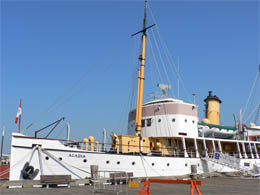
CSS Acadian |
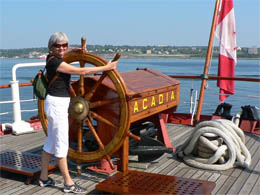
Nancy at the helm |

Scientist desk |
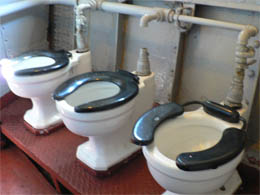
The “heads” |
NOTE: Acadia was the first ship in the hydrographic fleet to be outfitted with the new wireless telegraphy system designed by Marconi to keep the ship in contact with shore stations and other vessels. Later on, an alarm system was installed to warn operators of incoming distress calls, devised by Marconi after the loss of RMS Titanic in April of 1912.
The guide took our group through the bowels of the boat. It was very warm in those tight quarters – glad we only had five in our group. The interior was classy with beautiful mahogany and oak paneling and fine brass work. We visited the kitchen, the
refrigeration
room (with a telephone on the inside in case someone got locked in), the chart room, dinning areas, scientists’ fancy quarters (where linens and table clothes were used), captains’ quarters, crews’ quarters, engineer area (close to the engine) and quarters for the waiters and cooks. The coal-fired triple-expansion steam engine re-circulated distilled water and rarely had a breakdown over 56 years of operation. It was fascinating to think about the 60 guys who made this place home. One night, feeling restless, the guys had a hockey game in the dinning room using a frozen pork chop as the puck.
At 2:30, we were done with the Maritime Museum. We didn’t want to wait for FRED (the free tourist bus) to pick us up, so we headed up the hill to the Citadel. On the way, we stopped to visit St. Paul’s Anglican Church. Built in 1750 (commissioned by King George II), it was the first Anglican cathedral established outside of England and Canada’s oldest protestant place of worship. The building was fabricated in Boston and shipped to Halifax where it was erected. I liked the pipe organ and I was fascinated by the piece of metal debris (from the Halifax explosion of 1917) still lodged in the wall over the door to the sanctuary.
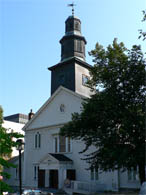
St. Paul’s Anglican Church |
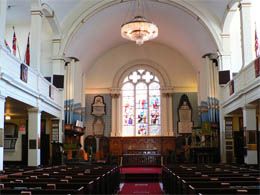
St. Paul’s Anglican Church sanctuary |
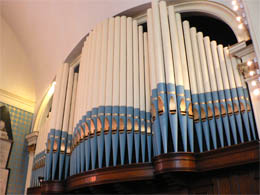
Cool pipe organ |
We didn’t have time to do the “Pier 21 Immigration Museum,” or the Keith’s Brewery or the Art Gallery, but decided to forge on to the Citadel.
We walked up the hill past the town clock. (The town clock, commissioned by Prince Edward, Duke of Kent, was built in 1803 as a joint effort between the town of Halifax and the military.)
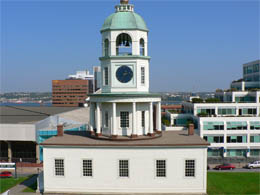
Town Clock with views of Halifax in the background
|
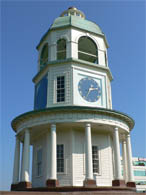
Town Clock - close-up
|
At the top of the hill, the tour buses (loaded with folks from cruise ships) were just pulling out when we arrived. The views of the Atlantic Ocean were nice up on the hill – but we did have to peak around between the tacky high rises in downtown Halifax below.
Four forts occupied the summit. Col. Edward Cornwallis was posted to this colony in 1749. The fourth fort was built out of concern that the Americans (south of the border) would attack the harbor. However, the fort was so formidable, it has never been attacked. The Citadel is restored to its 1856 vintage. The fort is a solid, impressive structure (in the shape of a star) with sturdy granite walls topped with grassy embankments. Massive canons line the top of the embankments. Costumed characters (circa 1850’s) strolled around the place along with guys in kilts playing bagpipes and soldiers firing the canons.
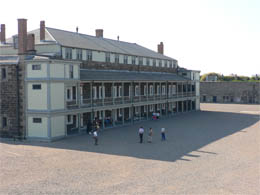
The Citadel |
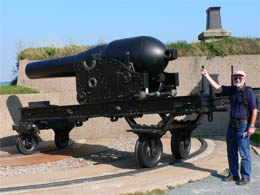
Bill fires the canon |
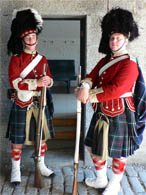
Soldiers (from the 1850’s) |
We wandered through on the barracks, which now house the historical museum, and watched the orientation film. Lots of nice, informative displays, but my brain was exploding from all the stuff I tried to cram in. We met for the 3:30 tour, hoping someone else could help us sort things out. However, the gal was so bored with her talk, she began to bore me, so we left the group and left the Citadel.
It was such a gorgeous afternoon, we decided to walk through the Public Gardens, but before we entered the gates, a woman was running down the street calling out to us, “Bill!!! Nancy!!!” It turned out to be Brenda, the businesswoman we met in Charlottetown while having a beer at Papa Joe’s. Brenda’s office was right across the street from where we were. Small world. It was great seeing her again. She needed to finish some work, so we agreed to meet at the Duke of Somebody’s Pub in 45 minutes for a beer.
Bill and I walked through the lovely gardens on that warm, sunny day. Everyone was out enjoying the wonderful day. It was like a park in London – statues, well groomed grounds, tall elegant trees, and a pond here and there – you get the picture.
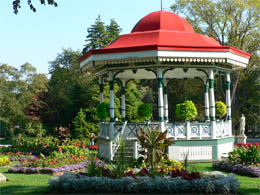
Public Garden |
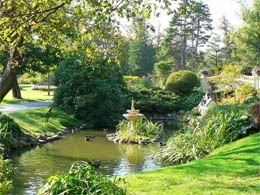
Garden pond |
We walked into “The Old Burying Ground.” Between 1749 and 1844, over 12,000 people were buried here. We found Alexander Keith’s Grave – the guy who started Keith’s brewery. Somebody had left him a can of Keith’s beer on his tombstone – cute.
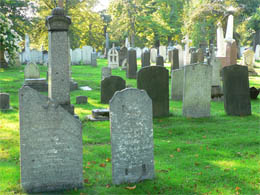
“The Old Burying Ground” |
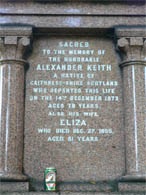
Alexander Keith’s tombstone (with a can of Keith’s beer) |
We met Brenda at the Duke of Somebody’s Pub at the designated time and caught up on the last couple days since we had seen her. Then she drove us around town, pointing out sights of Halifax that we wouldn’t have seen without her as our tour guide. We saw lots of wonderful old neighborhoods and three colleges in town (two of which Brenda attended). We also saw her childhood home (the one her father built), her catholic elementary school and high school. It was a stroll down memory lane.
We stopped at the Fairview Lawn Cemetery where 121 victims of the Titanic were buried – mostly crewmembers. Several of the simple graves just display a number, with no name. The saddest were the graves of the children, especially the 2-year old unknown boy. Someone had left stuffed animals on the children’s graves. Although it happened over 95 years ago, the Titanic tragedy still affects us today.
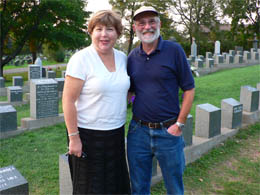
Bill and Brenda - Fairview Lawn Cemetery |
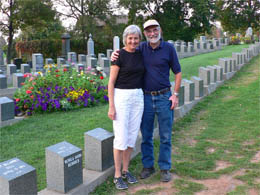
Bill and Nancy among the graves of the Titanic victims |
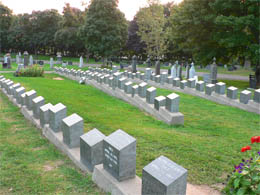
Rows of graves of people who died in the Titanic wreck |

Grave of unknown Titanic victim |
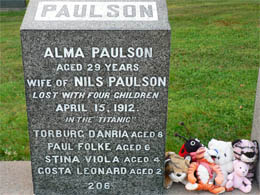
Grave of mother and her four children |
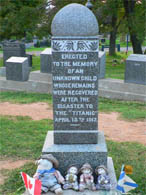
Grave of unknown child (with stuffed animals) |
Brenda drove us back through town and showed us the Duke of Kent’s round church. The Duke also designed the clock tower at the entrance to the Citadel.
About 7 o’clock, Brenda dropped us off at the Sweet Basil Restaurant for dinner. It was a quiet, romantic place. We enjoyed our Halibut in passion fruit and ravioli stuffed with squash and herbs.
We took the ferry back to Dartmouth and made it back to our B&B about 9. We chatted a little with Marge and Ron and met another one of their daughters. (They have 5 daughters – all named Mary – e.g., Mary Kate, Mary Anne, etc. All five daughters served in the Naval Reserves. That was enough to drive the Reserves crazy!)
We went upstairs to call Amy (she got the job). We also talked to Zi. (Brian was out of town.) We miss them a lot. (I was too tired to write in my journal.)
9/27 - Thursday – Halifax to Lunenburg
Marg served us another yummy breakfast – best so far. Hit the road about 9:30. Our first stop was Peggy’s Cove, 26 miles southwest of Halifax. Pegg’s Cove is a picture perfect fishing village accented with a perfect lighthouse on the ocean. However, “perfectness” has its price – the place was swarming with tour buses. We crawled all over each other just to get the right shot. (I do think the photos I took in Peggy’s Cove are some of my best.)
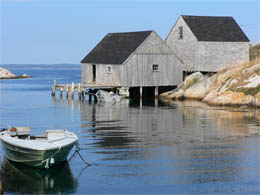
Peggy’s Cove |
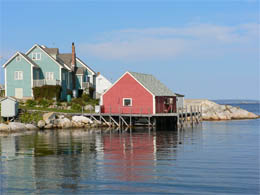
Peggy’s Cove |
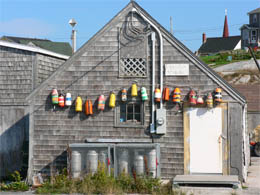
Buoys hanging on boathouse |
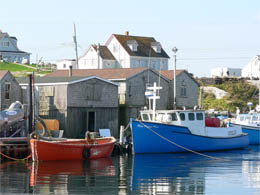
Town Harbor |
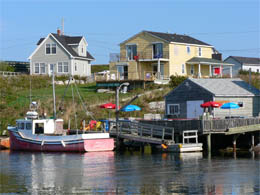
Lobster boat docked |
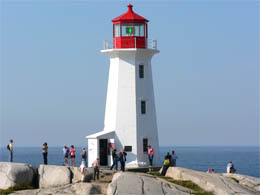
Lighthouse |
William E. deGarthe (1907–1983) was a painter and sculptor who lived in Peggy’s Cove. He was born in Helsinki, Finland and immigrated to Canada in 1926. In 1948 he bought a summer cottage in Peggy’s Cove and then moved there
permanently
in 1955. He carved a monument to the fishermen in Nova Scotia on a 100-ft slab of granite outcropping next to his house. The sculpture depicts 32 fishermen, their wives and children.
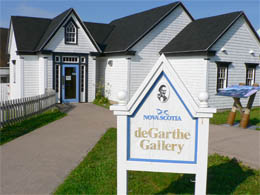
Where deGarthe lived |
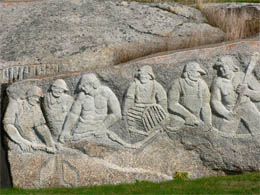
Fishermen monument |
Less than a mile out of town is a simple memorial to the victims who died in Swissair Flight 111. On September 2, 1998, the plane took off from New York’s JFK airport bound for Geneva, Switzerland. A fire was reported on board just before the crash. 229 people were killed. The modest monument, a rock structure, created just the right place to honor the victims. The angled cuts in one large rock directed your eyes to the exact crash sight in the ocean.
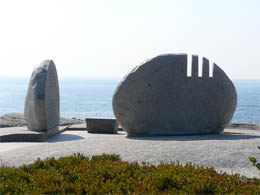
Monument to Swissair Flight 111 |
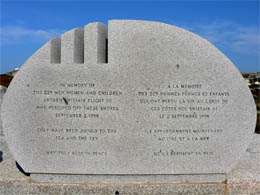
Monument to Swissair Flight 111 |
Back in the car, we took “The Bitch’s” advice and entered the freeway, cutting off some of the scenic route and the town of Chester. (Just how much beauty can one take?) Later, we got back on the scenic route right before Mahone Bay and stopped at the Visitor’s Center (no email from home). Mahone Bay has three wonderful old churches situated on the bay – wonderful view, but I missed the shot – oh well! The town was having a scarecrow festival – such clever things folks can do with scarecrows. We visited a few little shops in town and the pewter factory – but just couldn’t decide on anything. (Bill thought the town was too “cutesy.”)

Scarecrows and pumpkins |

Nancy and some tin-scarecrows |
We drove on down the road to Lunenburg and our Bed and Breakfast. This town is real, not a bit cutesy, with street after street of charming Victorian houses. It’s a UNESCO World Heritage site. We stayed in the delightful 1826 Maplebird House , located in the historical area. George Anderson (blacksmith) and son of John Anderson (United Empire Loyalist) built the place in 1826. The barn is still next-door. Susie and Barry, a couple of Brits, own and operate the place. (Susie once was a television director for an international wide world of sports program. Barry charms the guests with his humor – great place!)
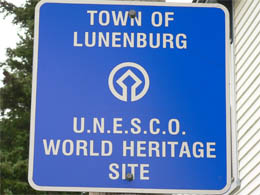
Lunenburg UNESCO World Heritage Site |
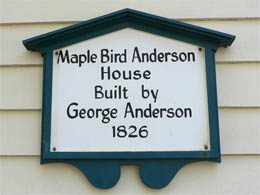
1826 Maple Bird Inn - UNESCO World Heritage Site |
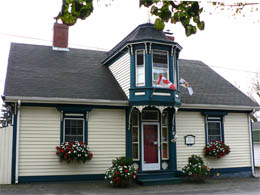
1826 Maple Bird Inn |
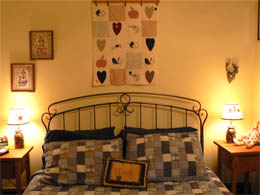
Our little bed |
The weather is turning ugly – gray skies and a big storm on the way. We walked a few blocks to the heart of town and shared a tuna sandwich at the Salt Shaker Deli – it had a nice gourmet twist to it. We came back to our room to figure out where we’d stay the next night. We gathered our dirty laundry to do our last wash of the trip.
We stopped in at the library, just across the street from our B&B, to check email – “You’ve got mail!” Amy wrote a note that my article about Kensington was in the Reader, but no mention of who won the contest. (The Reader was having a contest ($3,000 top prize) and soliciting people to send in stories about their neighborhood. I think it was just a big scam to fill their paper with stories they didn’t have to pay for – but at least I’m published.) Amy said the article made her cry.
We met rolly-polly, fun-loving Cheryl at the Visitor’s Center. She told Bill, “You look good – you can’t be retired.” She wanted to see if he had any hair under his baseball cap. When he removed the cap, revealing his curls, she really got excited. Cheryl was fun and efficient and made our arrangements in Annapolis Royal for the next night.
We went on down the road to do our laundry. I’m crazy about the signs posted on the walls of Laundromats – One of the signs said, “Be Nice or Leave.” We loaded up the washer and left during the wash cycle to explore more of Lunenburg. I get so excited dashing from street to street in this remarkable place. We saw St. John’s Anglican Church (founded 1753), Zion Lutheran Church (founded 1772), the old burying ground and then the Lunenburg Academy (1838). The Lunenburg Academy, now an elementary school, looks just like Harry Potter’s School for Wizards.
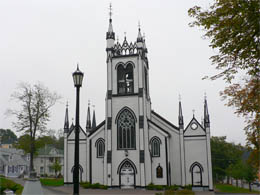
St. John’s Anglican Church |
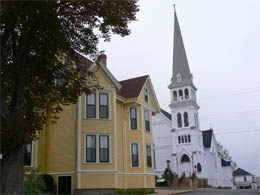
Zion Lutheran Church |
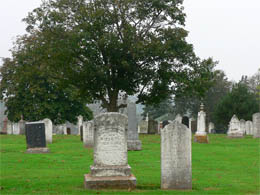
The old burying ground |
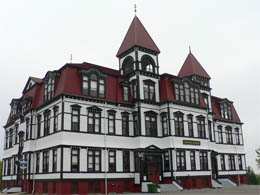
The Lunenburg Academy |
We drove back to the Laundromat to start the dry cycle – then dashed back to town to the Knot Pub for a big beer. What a lively place! The platters of fish and chips were huge and so were the patrons. Jolly group – definitely a place where the locals gather.
Back to the Laundromat at about 7 pm to gather our clean clothes. We returned to our B&B and then walked into town in the fog and mist to see the Bluenose II (sailing vessel) docked at the harbor. We had dinner at The Old Fish Factory (housed in the Lunenburg’s Maritime museum). We had haddock, shrimp and scallops – they were OK – plain grub – we expected something a little more special for the price. After dinner, we walked up a hill and back to our B&B – Love this little village. I can just feel the ghosts a’stirring. Long Day -- To bed we go!
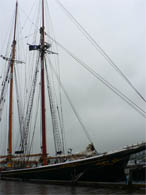
Bluenose II, through the mist |
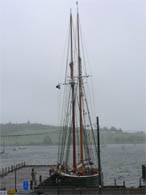
Another view of the Bluenose II |
|











